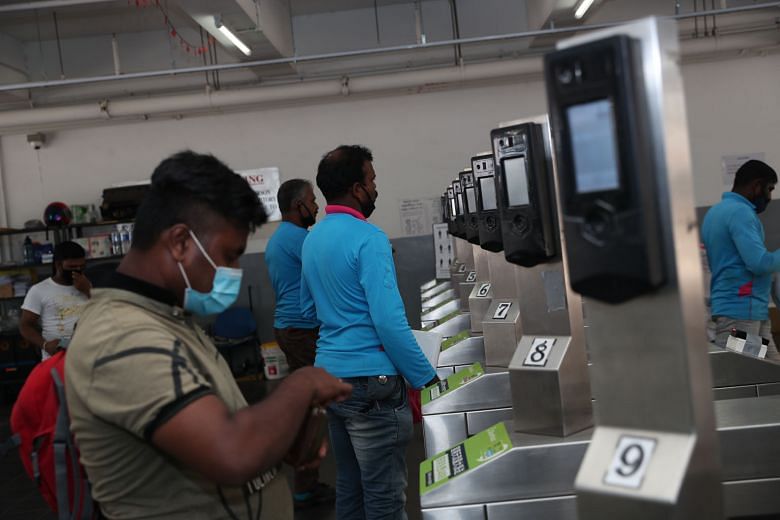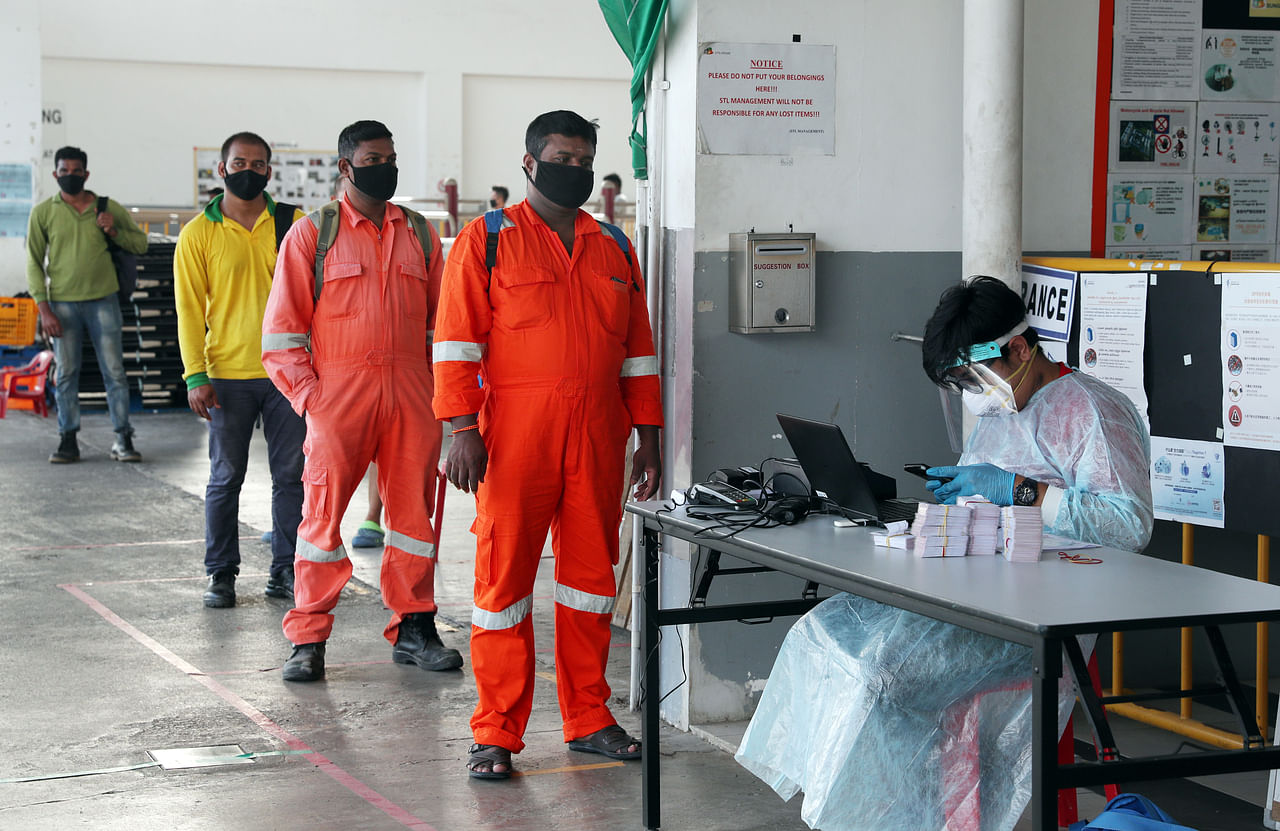Construction worker Ajith Kumar, 24, who resides in Singapore's largest foreign worker dormitory, says conditions have changed in recent months.
His 8m by 6m room at Sungei Tengah Lodge (STL), which he shares with 11 others, is cleaner, with cleaning supplies provided.
He uses an app on his mobile phone to scan a QR code near the room's entrance, to report his location to the authorities twice daily.
He hopes to be back at work soon, after a lapse of four months.
These are just a few changes among many made in the battle against Covid-19 in the dorms since early April, when the first dorms were gazetted as isolation areas.
Four-month battle
Yesterday, Singapore finished testing all 323,000 workers in dorms for Covid-19.
A "massive undertaking", as Education Minister Lawrence Wong, co-chair of the multi-ministry virus task force, said in a Facebook post.
And as of Monday, some nine in 10 of these workers - or 273,000 - have recovered or been tested to be free of Covid-19.
The journey to the current stage has taken four long and arduous months of many policies and measures implemented to meet a fast-evolving situation.
A microcosm of what has happened can be found in STL, which went from being one of the largest clusters to being Covid-19-free last month.
It was no mean feat to manage the then 23,000 workers when the dorm was first gazetted as an isolation area in early April, said Mr Simon Lee, chief operating officer of TG25, which runs STL.
"During that period, I was having only two hours of sleep (a night) for easily two weeks," he said, adding that it was a "mad rush" to get all the workers to return and stay in their rooms.
An especially challenging task was catering meals for everyone and maintaining hygiene and sanitation, he added, recalling "a lot of media attention" on the matter.

By this time, unsanitary conditions in some dorms had been placed in the spotlight. A Straits Times report on April 6 on conditions at S11 Dormitory @ Punggol described crowded rooms with cockroaches and overflowing toilets.
To improve conditions and manage the situation, Manpower Minister Josephine Teo announced the deployment of Forward Assurance and Support Teams (Fast) - comprising Ministry of Manpower (MOM), police and military officers.
Rigorous hygiene and sanitation measures were put in place, caterers were roped in to provide workers with three meals a day, and medical posts were set up to test and treat those who felt unwell.
Healthy workers in essential services were transferred to alternative sites like floating hotels and vacant Housing Board blocks, to separate them from infected workers and reduce work disruption.
In mid-May, Mr Wong announced plans to test all 323,000 workers in dorms for Covid-19.
Deputy Assistant Commissioner of Police Shu Su Yen, who leads the 36-person Fast team at STL, said it worked with the dorm's operator to keep track of each worker's status.
A team from the National University Hospital was on site for medical clearance.
"Working hand in hand with these two partners on site helped us ensure that no workers were left out of the testing," she said.
This paved the way for the dorm to be de-gazetted and cleared, block by block, of the coronavirus.
A safe return to work
Although Mr Ajith and his roommates have not been able to work for the last four months, they are the minority in STL. Close to 12,000 of about 19,000 workers now housed there - more than three in five - have gone back to work.
Islandwide, about 265,000 workers in the construction, marine and process sectors have been able to head back to work as of Thursday.
Yesterday, Mr Wong said that the vast majority of migrant workers in the dorms would be able to resume work by the end of the month.
"But our fight against the virus is not over. Just because we have Covid-cleared dorms today doesn't mean that we will automatically have Covid-safe dorms in the future," he warned.
In its latest update last night, the Health Ministry announced that four previous cases had been linked to form a new cluster at a dormitory at 66 Tech Park Crescent.
Many measures are in place to ensure that workers resuming work do not spark new Covid-19 cases.
Workers, for example, have to use the FWMOMCare app, released on May 18 by MOM, to report their health status and location daily.
Before they can return to work, employers have to obtain the relevant approvals from agencies, such as the Building and Construction Authority.
Only when all conditions, including measures such as staggered transport arrangements, are met, will the worker be given a green AccessCode - meaning he is cleared to return to work.
Employers were generally supportive of the measures.
Mr Nixon Loh, 48, general manager of Loh & Loh Construction, said he has always provided transport for his workers, who are also issued protective equipment and hand sanitiser when needed.
"Obviously now, there will be an increase in cost, which is unavoidable. The important thing is that we get to resume our projects," said Mr Loh, who has about 250 workers staying in STL.
Seven in 10 of his workers have the green AccessCode.
TG25's Mr Lee said his dorm implements checks at both the block and the exit to the dorm, where workers have to flash the green status on their phones' SGWorkPass app before they can leave.
In the last three weeks, he has also been helping to cohort workers, a measure introduced to prevent cross-transmissions by housing workers according to their work sites. He has helped 87 firms cohort more than 4,000 workers so far.
Mr Tan Fang Qun, deputy commander of the joint task force on dorms, said safe living measures are key to the safe resumption of work.

"Dorm operators have been working very closely with employers, Fast teams and workers to put in place proper segregation measures," he said, adding that these help to minimise mixing between workers of different floors or blocks and reduce potential transmissions.
Still, there will always be the risk of infections, especially since some who get Covid-19 do not display symptoms.
Mr Tan, who is director of planning and organisation development at MOM's foreign manpower management division, said a 14-day routine testing of all workers begins once a dorm is cleared.
"So when we do discover any infection, we are able to move in quite quickly and contain and arrest the spread of the virus," he said.
If a case pops up, the authorities will act by assessing the ground situation. If the dorm has proper enforcement of safe living measures, fewer workers will need to be isolated.
What's next
The work is not done and the goal is to further improve living conditions of migrant workers, with a further reduction of the density of workers in the dorms.
MOM has been holding consultations with both operators and health experts on quick-build dorms, to be ready by the end of the year. New specifications will ensure each worker gets more living space, with less sharing of facilities.
Other arrangements include fitting out former schools and vacant factories to house workers.
Mr Tan said more information on plans to reduce worker density in the dorms will be announced in the coming weeks.
Another area of focus is the emotional well-being of workers.

Mr Tan outlined efforts to step up communication with workers and to work with non-governmental organisations and worker ambassadors.
Since the start of the crisis, the welfare of workers and how to help them had been a top priority.
Plans to possibly have staggered rest days when workers can leave their dorms for recreational purposes, and for more mental health support, were revealed to ST on Wednesday.
At STL, Mr Lee is already working with the Salvation Army to provide counselling services for the workers, which started this month.
DAC Shu also said that the medical post at STL looks out for any signs of depression or insomnia, and the team works with migrant workers' help group HealthServe to provide mental health support.
As Mr Ajith and the over 300,000 others staying in dorms return to work in the coming weeks, these plans offer hope that, after a long day of labour, they can return to a more supportive and comfortable living environment.











